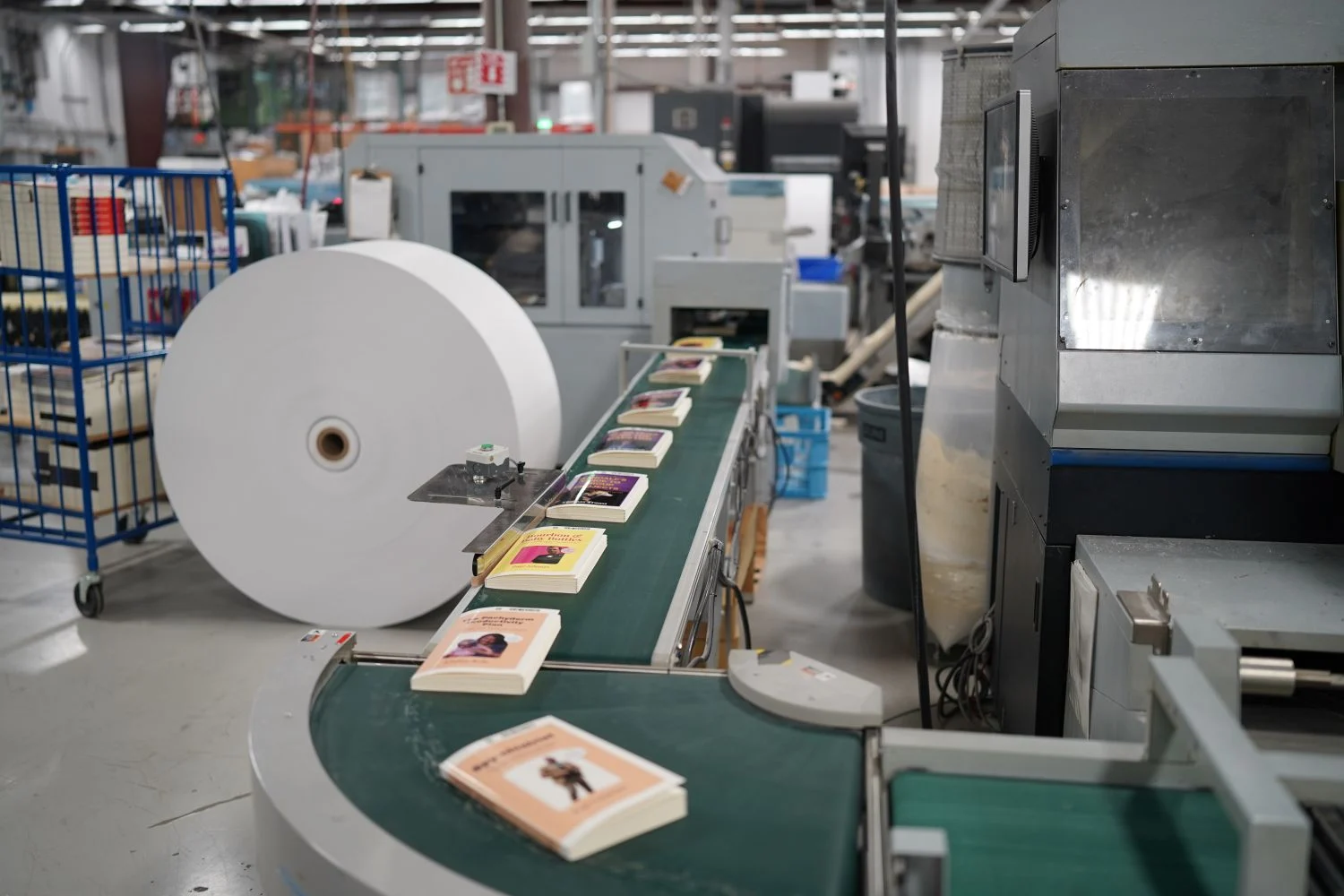In the world of publishing and commercial printing, customers often have questions about how to choose the right materials and finishes for their books, magazines and catalogs. At Walsworth, we hear many of these questions regularly.
Below, we’ve compiled some of the frequently asked questions (and clear answers) about paper stock, binding methods, finishing techniques, durability, mailing, environmental considerations and cost/value trade-offs. Use this as a guide to make informed decisions for your next print project.
Paper Stock Selection
Choosing the proper paper stock is a crucial first step. The paper affects not only the look and feel of your publication, but also durability, mailing weight and cost. Here are some common questions:
Should I use coated or uncoated paper for my project?
If you want vibrant, sharp imagery and a polished feel, go with a coated stock. Coated paper has a smooth surface created by a coating that fills in the paper’s fibers; ink sits on top of this coating rather than soaking in, which yields more intense colors and crisper detail in photos and graphics. Coated sheets also tend to be more resistant to dirt and moisture. This makes coated paper popular for magazines, catalogs and any piece where you want a slick, professional look.
Uncoated paper, by contrast, has no surface coating – it’s more porous and has a natural, textured feel. Ink penetrates uncoated sheets more, so colors appear a bit softer or muted compared to coated stock. Many designers choose uncoated for a warmer, more elegant look, and because it’s easier to write on.
In short, use coated paper for high-impact, full-color pieces; consider uncoated paper for a tactile, upscale feel or when a reader-friendly matte look is preferred.
Gloss vs. matte paper: Which finish should I choose?
Coated paper comes in gloss and matte finishes. A gloss-coated paper has a high sheen that makes colors “pop” – images printed on gloss look bright and crisp. However, gloss is very reflective and can produce glare under light. A matte-coated paper yields a subtle, diffuse look with minimal shine – colors are a bit more muted but glare-free and sophisticated. Matte coatings are ideal for easy readability or a premium feel. Semi-gloss stocks offer a middle ground. Choose gloss for vivid photos; choose matte to avoid reflections.
What do paper weights (like 80# text or 100# cover) mean, and how do I choose the right weight?
Paper “weight” refers to the weight of 500 uncut sheets in its basic size. Text and cover stocks use different scales: 60# text is similar to copy paper, whereas 60# cover is much thicker (around 110# text). Be sure to note text vs. cover. Heavier stocks feel substantial and reduce show-through, but increase costs. Always ask your printer for samples to feel the difference.
Binding Methods
Binding affects durability, appearance and cost. Different styles suit different projects:
What’s the difference between perfect binding and saddle stitching?
Saddle stitching staples a folded booklet and is cost-effective for up to ~100 pages, depending on the project. It lays flat, but is generally considered to be not as aesthetically pleasing as perfect binding.
Perfect binding glues a stacked book to a wrap-around cover, creating a square spine (which can be printed on). It accommodates higher page counts and feels more like a book.
When should I choose hardcover (case binding) instead of softcover?
Hardcover (case binding) encases sewn or glued signatures in rigid boards, making books extremely durable and long-lasting. Ideal for yearbooks, textbooks and coffee-table books.
Softcover (perfect-bound paperback) is more cost-efficient and portable, but less durable. Choose hardcover for longevity and prestige; choose softcover for everyday or budget-sensitive projects.
Finishing Techniques
Should I get my cover laminated or UV coated? What’s the difference?
UV coating is a liquid film cured by UV light. It’s fast and cost-effective, offering moderate protection and a high-gloss or matte finish.
Lamination seals a clear film onto the sheet, providing maximum protection against moisture and abrasion, but at a higher cost and longer turnaround.
Choose UV for cost-effective shine; choose lamination for heavy-duty, long-term protection.
What is embossing (or debossing) in print, and how is it used?
Embossing raises a design above the paper; debossing presses it below. Both add a tactile, elegant effect. Combine with foil for foil embossing.
What is foil stamping, and when should I consider it?
Foil stamping transfers metallic or pigmented foil via heat and pressure, producing a brilliant, reflective finish. Ideal for logos, titles and premium accents. Consider it for high-end book covers and luxury magazines or catalogs.
What is spot UV (spot gloss), and why use it?
Spot UV applies a clear glossy coating only to specific areas, creating contrast and a subtle raised texture. It’s a great way to add extra pop or shine on a variety of projects.
Durability & Mailing Considerations
How can I make sure my books or catalogs are durable enough for heavy use?
- Use heavier paper (60–80# text, 80–100# cover), coated stocks and protective coatings or lamination.
- Choose strong binding: PUR-glued perfect binding or Smyth-sewn signatures for books that open flat.
- Consider mechanical bindings (Wire-O, plastic coil) for manuals that must lay flat.
What should I consider if I plan to mail my magazines or catalogs?
- Weight & postage: Postage, in some cases, is driven by weight, and a certain “pound” weight of paper may be required. Using the wrong paper or making your mail piece too heavy may eliminate certain discounts.
- Protective packaging: Polybagging adds cost but helps protect pieces during transit.
- Design for mailing: Make sure you are designing your mail piece for the correct size and class of mail to reach optimal discounts, in addition to leaving space for address, barcodes and indicia.
Environmental & Sustainability Considerations
Are there environmentally friendly options for paper and finishes?
- FSC-certified paper: Many print buyers choose paper certified by the Sustainable Forest Initiative® (SFI®) and the Forest Stewardship Council® (FSC®). Many also seek out print providers with established chain of custody procedures to ensure that they purchase, track, produce and deliver products with raw materials harvested and produced from responsible and renewable sources.
- Recycled paper: Many printers offer recycled paper as a sustainable option for companies looking to reduce their environmental impact.
- Vegetable-based inks reduce environmental impact when compared to traditional petroleum-based inks.
Cost and Value Considerations
How do paper, binding and finishing choices impact cost, and where should I invest for the best value?
- Binding & format: Saddle stitch is most budget-friendly; perfect bind adds polish; hardcover is premium.
- Paper upgrades: A modest weight increase can greatly boost perceived quality.
- Special finishes: Choose one “wow” factor (foil, emboss, spot UV) and apply it selectively to control cost.
- Core quality: Never skimp on binding strength or legibility – those are fundamental.
- Cover options: Choosing a self cover, which means the same paper is used for the body and cover of a project, is a good way to save on costs. Using a separate, heavier cover stock can enhance durability but generally results in higher costs.
Work closely with your printer to balance budget and impact, ensuring you invest where your audience will notice.
Have more questions?
This FAQ covers some of the most common material and finishing questions we hear at Walsworth. If you have other questions – whether about inks, printing techniques or anything else print-related – don’t hesitate to reach out. With decades of experience in book, magazine and catalog production, Walsworth’s team is always ready to help guide you to the best choices for your project’s needs and budget. Happy printing!
* This article was developed with assistance from OpenAI’s GPT-o3 Pro Deep Research large language AI model.






